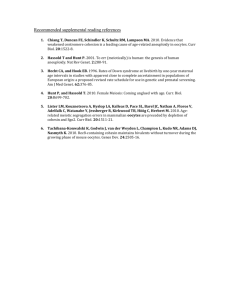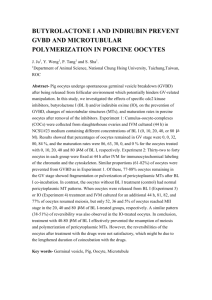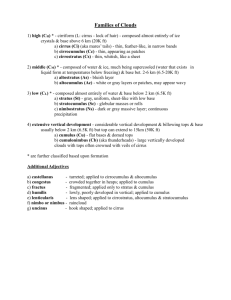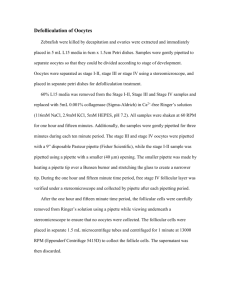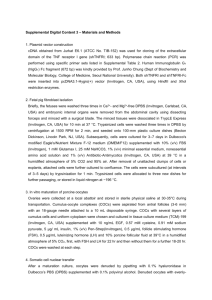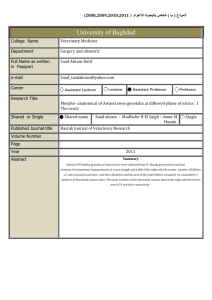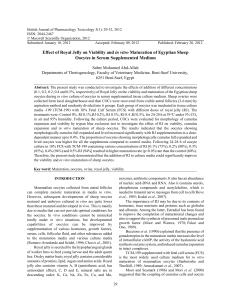File S1. Validation of the protocol used for mechanical removal of
advertisement
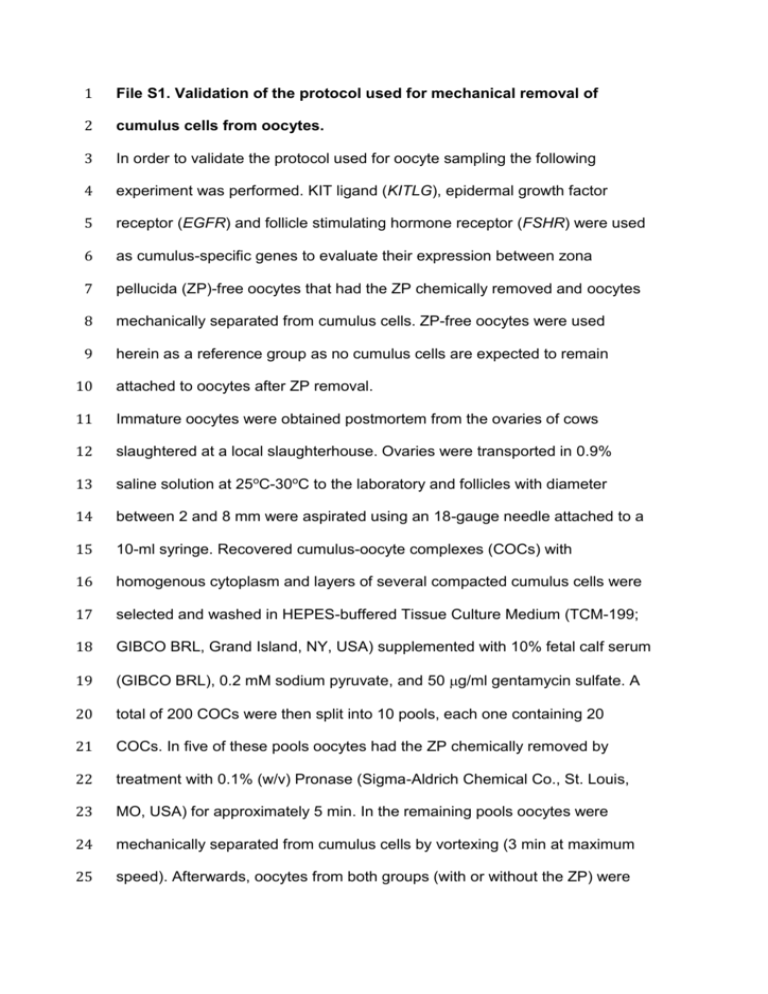
1 File S1. Validation of the protocol used for mechanical removal of 2 cumulus cells from oocytes. 3 In order to validate the protocol used for oocyte sampling the following 4 experiment was performed. KIT ligand (KITLG), epidermal growth factor 5 receptor (EGFR) and follicle stimulating hormone receptor (FSHR) were used 6 as cumulus-specific genes to evaluate their expression between zona 7 pellucida (ZP)-free oocytes that had the ZP chemically removed and oocytes 8 mechanically separated from cumulus cells. ZP-free oocytes were used 9 herein as a reference group as no cumulus cells are expected to remain 10 attached to oocytes after ZP removal. 11 Immature oocytes were obtained postmortem from the ovaries of cows 12 slaughtered at a local slaughterhouse. Ovaries were transported in 0.9% 13 saline solution at 25oC-30oC to the laboratory and follicles with diameter 14 between 2 and 8 mm were aspirated using an 18-gauge needle attached to a 15 10-ml syringe. Recovered cumulus-oocyte complexes (COCs) with 16 homogenous cytoplasm and layers of several compacted cumulus cells were 17 selected and washed in HEPES-buffered Tissue Culture Medium (TCM-199; 18 GIBCO BRL, Grand Island, NY, USA) supplemented with 10% fetal calf serum 19 (GIBCO BRL), 0.2 mM sodium pyruvate, and 50 g/ml gentamycin sulfate. A 20 total of 200 COCs were then split into 10 pools, each one containing 20 21 COCs. In five of these pools oocytes had the ZP chemically removed by 22 treatment with 0.1% (w/v) Pronase (Sigma-Aldrich Chemical Co., St. Louis, 23 MO, USA) for approximately 5 min. In the remaining pools oocytes were 24 mechanically separated from cumulus cells by vortexing (3 min at maximum 25 speed). Afterwards, oocytes from both groups (with or without the ZP) were 26 washed three times in PBS with 0.1% polyvinyl-pyrrolidone (PVP) to 27 completely remove cumulus cells. Pooled oocytes from each group were 28 thoroughly checked for the presence of cumulus cells under a 29 stereomicroscope (Figure S1) and stored at -80oC in 0.2 ml polystyrene PCR 30 tubes with 5 l of PBS containing 0.1% PVP and 1 U/l of RNase inhibitor 31 (RNase OUT, Invitrogen, Carlsbad, CA, USA). 32 Transcript abundance was evaluated by real-time RT-PCR essentially as 33 described in Material and Methods. Briefly, expression of three target genes 34 (KITLG, EGFR and FSHR) and three reference genes (RPL15, PPIA and 35 GUSB) was evaluated to address the issue of cumulus cell contamination. 36 Primers for amplification of EGFR and FSHR were based on previously 37 reported sequences [1] whereas primers for amplification of KITLG were a gift 38 of Dr. José Buratini Júnior. All transcripts were amplified for 45 cycles as 39 described in Material and Methods, except that cDNA used as template was 40 diluted eight fold. Moreover, 1 x SYBR Green PCR Master Mix (Applied 41 Biosystems, Foster City, CA, USA) and 200 nM of primers were used for 42 amplification of KITLG, EGFR and FSHR. Positive control reactions were 43 performed using cDNA from cumulus cells. Specificity of primers was 44 confirmed by melt-curve analysis, electrophoresis onto 2% agarose gels and 45 sequencing of PCR products (see Material and Methods). The expression 46 levels of targets in relation to reference genes were compared by ANOVA 47 (see Material and Methods) regarding the two experimental groups (with or 48 without the ZP). 49 Since KITLG, EGFR and FSHR have been described as being expressed 50 exclusively by cumulus cells [1–4], we expected absence of transcripts for 51 these genes in the samples evaluated in the present experiment. This was 52 found to be the case for FSHR but transcripts for KITLG and EGFR were 53 found in all samples (Figure S2). The absence of transcripts from FSHR 54 indicates that there were not contaminating cumulus cells regardless of the 55 presence of the ZP. Furthermore, although transcripts from KITLG and EGFR 56 were present in the samples, no difference in their expression level was found 57 between oocytes with and without the ZP (Figure S2). No effect of 58 experimental group was found even when expression of KITLG, EGFR, 59 RPL15, PPIA and GUSB was evaluated without normalization by reference 60 genes (Figure S3). The existence of contaminating cells should result in 61 higher amounts of transcripts, mainly KITLG and EGFR that have been 62 reported to be specific of cumulus cells [1–4]. Altogether, these results 63 indicate that, if any, contamination of oocytes with RNA from cumulus cells 64 was at similar levels between oocytes with and without the ZP. 65 In order to provide further evidence of absence of contaminating cumulus 66 cells, a second experiment was performed in which expression of KITLG and 67 EGFR was compared between denuded oocytes and cumulus cells. We 68 expected that albeit present in denuded oocytes with the ZP, transcripts from 69 KITLG and EGFR would be more abundant in cumulus cells. In this regard, 70 100 COCs were obtained as described above and split into 5 pools, each one 71 containing 20 COCs. Cumulus cells were partially removed from pooled 72 oocytes by gentle pipetting in PBS with 0.1% PVP followed by centrifugation 73 of the cells at 300 x g for 5 min. After removal of the supernatant, the cell 74 pellets were stored at -80oC in 0.2 ml polystyrene PCR tubes. Additionally, 75 partially denuded oocytes corresponding to each pool were vortexed to 76 remove the remaining cells and stored as described above. Transcript 77 abundance was analyzed as described above using RPL15, PPIA and GUSB 78 as reference genes. In agreement with our hypothesis expression of EGFR 79 was 3.2-fold greater (P = 0.002) in cumulus cells compared to denuded 80 oocytes (Figure S4). However, expression of KITLG was decreased (P = 81 0.002) in cumulus cells by 4.2 fold in comparison to denuded oocytes (Figure 82 S4), further indicating that expression of this gene cannot be used for analysis 83 of cumulus cell contamination in oocytes. 84 In conclusion, we found no difference on expression of cumulus-specific 85 genes between ZP-free oocytes and oocytes that had cumulus cells 86 mechanically removed, indicating that both methods are reliable for analysis 87 of oocyte gene expression. 88 89 References 90 1. 91 Effect of follicle size on mRNA expression in cumulus cells and oocytes of 92 Bos indicus: an approach to identify marker genes for developmental 93 competence. Reprod Fertil Dev 21: 655–664. 94 2. 95 transcriptionally silent following somatic cell nuclear transfer in a mouse 96 model. J Zhejiang Univ Sci B 8: 533–539. 97 3. 98 between oocytes and follicle cells: ensuring oocyte developmental 99 competence. Can J Physiol Pharmacol 88: 399–413. Caixeta ES, Ripamonte P, Franco MM, Junior JB, Dode MAN (2009) Tong G, Heng B, Ng S (2007) Cumulus-specific genes are Kidder GM, Vanderhyden BC (2010) Bidirectional communication 100 4. 101 synthesis in porcine oocyte-cumulus complexes during in vitro maturation. 102 Endocr Regul 46: 225–235. 103 Nagyova E (2012) Regulation of cumulus expansion and hyaluronan

